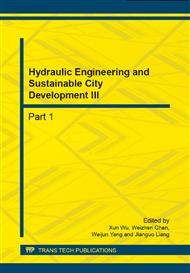[1]
Uzoagbala EM. Water demand management and water scarcityproblems in Nigeria Towns. Sub Sahara Bull (2006)4(2), p.84–90.
Google Scholar
[2]
Yan Han, Shi-guo Xu, Xiang-zhou Xu. Modeling Multisource Multiuser WaterResources Allocation. Water Resour Manage(2008)22, pp.911-923.
DOI: 10.1007/s11269-007-9201-0
Google Scholar
[3]
BinBin Huang, FaLiang Gui, XiaoHui Zhang. Study of the Optimal Water Resources Allocation Scenarios in Pingxiang City. CSISE 2011, (2011) AISC 105, p.487–493.
DOI: 10.1007/978-3-642-23756-0_78
Google Scholar
[4]
Emma E. Ezenwaji, Raymond N. C. Anyadike, Nnaemeka I. Igu. Optimal allocation of public water supply to the urban sectors of Enugu, Nigeria: a linear programming approach. Water Sci (2014) 4, p.73–78.
DOI: 10.1007/s13201-013-0131-0
Google Scholar
[5]
Holland, J.H. Adaptation in Natural and Artificial Systems. University of Michigan Press, Cambridge. Mass, (1975).
Google Scholar
[6]
Nei, M. and W.H. Li. Mathematical model for studying genetic variation in terms of restriction endonucleases. Proceedings of the National Academy of Sciences. (1979)76(10), pp.5269-5273.
DOI: 10.1073/pnas.76.10.5269
Google Scholar
[7]
Goldberg, D.E. Genetic Algorithms in Search, Optimization AND Machine Learning. Addison Wesley, Reading, Mass, (1989).
Google Scholar
[8]
Deb, Kalyanmoy. Optimization for Engineering Design. Journal of Prentice Hall of India, (1995).
Google Scholar
[9]
Oliveira, R., Loucks, D.P. Operating rules for multi reservoir system. Journal of Water Resour. Res. (1997)33 (4), pp.839-852.
DOI: 10.1029/96wr03745
Google Scholar
[10]
Aly, A.H., Peralta, R.C. Comparison of a genetic algorithm and mathematical programming to the design of groundwater clean up system. Journal of Water Resour. Res. (1999)35 (8), pp.2415-2426.
DOI: 10.1029/1998wr900128
Google Scholar
[11]
Deb, K., et al. A fast and elitist multiobjective genetic algorithm: NSGA-II. Journal of Evolutionary Computation, IEEE Transactions on. (2002)6(2), pp.182-197.
DOI: 10.1109/4235.996017
Google Scholar
[12]
Long Wang, Tong-guang , Wang Yuan Luo. Improved non-dominated sorting genetic algorithm (NSGA)-II in multi-objective optimization studies of wind turbine blades. Journal of Mathematics and Mechanics. (2011)32(6), pp.739-748.
DOI: 10.1007/s10483-011-1453-x
Google Scholar
[13]
Rajni Goyal, Shiv Prasad Yadav, Amar Kishor. A new approach to solve a general system of linear inequalities based on NSGA-II. International Journal of System Assurance Engineering and Management. (2012)3(1), pp.17-23.
DOI: 10.1007/s13198-012-0087-8
Google Scholar
[14]
Alireza Soroudi, Mehdi Ehsan. Application of a Modified NSGA Method for Multi-Objective Static Distributed Generation Planning. Arabian Journal for Science and Engineering. (2011)36(5), pp.809-825.
DOI: 10.1007/s13369-011-0077-1
Google Scholar


